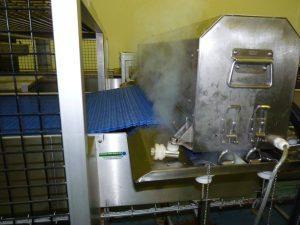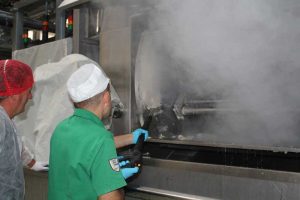Conveyor belt cleaning systems are an essential component of conveyor systems in various industries such as mining, food processing, agriculture and manufacturing. These systems are designed to remove carryback, spillage and debris from the conveyor belt, ensuring smooth and efficient operation. Belt cleaning systems come in a variety of designs, including scrapers, brushes and air knives, each tailored to specific applications and conveyor belt types.
The primary goal of these systems is to maintain a clean conveyor belt surface, which is crucial for preventing material build-up, reducing the risk of belt mistracking, and ensuring product quality and safety. Belt cleaning systems play a critical role in maintaining the overall efficiency and productivity of conveyor systems. By effectively removing carryback and spillage, these systems help to prevent material accumulation on the return rollers, pulleys and other conveyor components.
This not only reduces the risk of equipment damage and downtime but also contributes to a safer working environment. Additionally, clean conveyor belts are essential for preventing cross-contamination in food processing and pharmaceutical industries, ensuring compliance with strict hygiene standards. Overall, belt cleaning systems are an integral part of conveyor operations, contributing to improved performance, workplace safety and environmental sustainability.
Summary
- Belt cleaning systems are essential for maintaining conveyor belt performance and workplace safety.
- Proper belt cleaning leads to improved conveyor belt performance and reduces the risk of material carryback.
- Implementing belt cleaning systems can increase workplace safety by reducing the risk of slips, trips, and falls.
- Regular cleaning and maintenance can extend the lifespan of conveyor belts, saving on replacement costs.
- Effective belt cleaning systems can reduce downtime and maintenance costs, improving overall operational efficiency.
Improved Conveyor Belt Performance
Reducing Friction and Wear
Carryback and spillage can cause material buildup on the conveyor belt surface, leading to increased friction and wear. This can result in mistracking, belt slippage, and premature wear and tear on the belt and other conveyor components.
Maintaining a Smooth Conveyor Belt Surface
By effectively removing carryback and spillage, belt cleaning systems help to maintain a clean and smooth conveyor belt surface, reducing friction and wear. This not only extends the lifespan of the conveyor belt but also ensures consistent and reliable performance.
Improving Material Transfer Efficiency
Clean conveyor belts allow for better material discharge, reducing the risk of blockages and spillage at transfer points. This is particularly important in industries such as mining and bulk material handling, where efficient material transfer is crucial for maintaining high throughput and productivity. Overall, the implementation of a belt cleaning system can lead to improved conveyor belt performance, reduced maintenance requirements, and increased operational efficiency.
Increased Workplace Safety

Workplace safety is a top priority in any industry, and conveyor belt cleaning systems play a crucial role in ensuring a safe working environment. Carryback and spillage on conveyor belts can create hazardous conditions for workers, increasing the risk of slips, trips, and falls. In addition, material buildup on the conveyor belt surface can lead to mistracking and potential entanglement hazards.
By effectively removing carryback and spillage, belt cleaning systems help to eliminate these safety risks, creating a safer working environment for employees. Furthermore, clean conveyor belts contribute to better visibility and inspection of the belt surface, allowing for early detection of potential issues such as belt damage or tracking problems. This proactive approach to maintenance helps to prevent accidents and unplanned downtime, ultimately improving workplace safety.
In industries where hygiene is critical, such as food processing and pharmaceuticals, clean conveyor belts are essential for preventing cross-contamination and ensuring product quality and safety. Overall, the implementation of a belt cleaning system not only improves conveyor performance but also enhances workplace safety for employees.
Extended Conveyor Belt Lifespan
Conveyor belts are a significant investment for any operation, and extending their lifespan is crucial for reducing maintenance costs and downtime. Belt cleaning systems play a key role in prolonging the life of conveyor belts by preventing premature wear and damage. Carryback and spillage can cause abrasive material buildup on the belt surface, leading to increased friction and wear.
Over time, this can result in belt damage, requiring costly repairs or even replacement. By effectively removing carryback and spillage, belt cleaning systems help to maintain a clean and smooth conveyor belt surface, reducing the risk of premature wear and extending the lifespan of the belt. In addition to preventing wear and damage, belt cleaning systems also contribute to the overall maintenance of the conveyor system.
Clean conveyor belts reduce the risk of material buildup on other components such as pulleys, idlers, and skirts, which can lead to additional maintenance requirements. By keeping the entire conveyor system clean and free from debris, belt cleaning systems help to reduce maintenance costs and extend the overall lifespan of the equipment. Ultimately, implementing a belt cleaning system is an investment in the longevity of conveyor belts and the overall efficiency of the operation.
Reduction in Downtime and Maintenance Costs
Downtime and maintenance costs are significant concerns for any operation that relies on conveyor systems. Carryback and spillage on conveyor belts can lead to increased maintenance requirements and unplanned downtime. Material buildup on the belt surface can cause mistracking, blockages at transfer points, and increased wear on the belt and other components.
This can result in frequent stoppages for maintenance and repairs, leading to lost productivity and increased costs. By effectively removing carryback and spillage, belt cleaning systems help to reduce these maintenance issues, resulting in less downtime and lower maintenance costs. Furthermore, clean conveyor belts contribute to more efficient operation and reduced wear on the entire conveyor system.
By maintaining a clean and smooth belt surface, belt cleaning systems help to prevent material buildup on pulleys, idlers, and skirts, reducing the risk of component wear and damage. This proactive approach to maintenance not only reduces downtime for repairs but also extends the overall lifespan of the equipment. Ultimately, implementing a belt cleaning system can lead to significant cost savings by minimising downtime and reducing maintenance requirements.
Environmental Benefits

Minimising Material Loss and Environmental Contamination
Carryback and spillage on conveyor belts can lead to material loss and environmental contamination. In industries such as mining and bulk material handling, this can result in significant environmental impact through dust emissions and soil contamination.
Contributing to Sustainable Operation Practices
By effectively removing carryback and spillage, belt cleaning systems help to minimise material loss and environmental contamination, contributing to sustainable operation practices. Furthermore, clean conveyor belts contribute to better dust control within the facility. Material buildup on the belt surface can lead to dust emissions during material transfer and handling processes.
Reducing Dust Emissions and Environmental Impact
By maintaining a clean belt surface, belt cleaning systems help to reduce dust emissions, creating a healthier working environment for employees and minimising environmental impact. Additionally, by reducing wear on the conveyor system through effective cleaning, these systems help to minimise the generation of particulate matter from abrasive material buildup. Overall, implementing a belt cleaning system is not only beneficial for operational efficiency but also contributes to environmental sustainability.
Compliance with Industry Regulations
Compliance with industry regulations is a critical consideration for any operation using conveyor systems. In industries such as food processing, pharmaceuticals, and mining, strict hygiene standards and environmental regulations must be adhered to. Clean conveyor belts are essential for meeting these regulations by preventing cross-contamination in food processing facilities and minimising environmental impact in mining operations.
By effectively removing carryback and spillage, belt cleaning systems help operations to comply with these regulations by maintaining clean conveyor belts that meet industry standards. Furthermore, workplace safety regulations also require operations to minimise hazards related to material handling equipment such as conveyors. Belt cleaning systems play a crucial role in ensuring compliance with these regulations by eliminating safety risks associated with carryback and spillage on conveyor belts.
By maintaining a clean and safe working environment for employees, these systems help operations to meet workplace safety standards set by regulatory authorities. Overall, implementing a belt cleaning system is essential for ensuring compliance with industry regulations across various sectors. In conclusion, belt cleaning systems are an integral part of conveyor operations in various industries.
These systems play a crucial role in improving conveyor performance, enhancing workplace safety, extending conveyor belt lifespan, reducing downtime and maintenance costs, providing environmental benefits, and ensuring compliance with industry regulations. By effectively removing carryback and spillage from conveyor belts, these systems contribute to operational efficiency, cost savings, environmental sustainability, and regulatory compliance. Implementing a comprehensive belt cleaning system is essential for any operation looking to maximise the performance and longevity of its conveyor systems while meeting industry standards for safety and environmental responsibility.
FAQs
What is a belt cleaning system?
A belt cleaning system is a set of components designed to remove material carryback from the conveyor belt. It typically includes a primary and secondary cleaner, as well as other accessories such as belt scrapers, belt ploughs, and belt brushes.
What are the benefits of a well-maintained belt cleaning system?
A well-maintained belt cleaning system can help to improve conveyor performance, reduce material carryback, minimise spillage, and increase the overall efficiency of the conveyor system. It can also contribute to a safer working environment and lower maintenance costs.
How does a belt cleaning system improve conveyor performance?
By effectively removing material carryback from the conveyor belt, a belt cleaning system helps to prevent build-up on idlers, pulleys, and other conveyor components. This can reduce the risk of belt mistracking, premature wear, and damage to the conveyor system, leading to improved performance and longevity.
What are the safety benefits of a well-maintained belt cleaning system?
A well-maintained belt cleaning system can help to reduce the risk of slip and fall accidents caused by material spillage on walkways and work areas around the conveyor system. It can also contribute to a cleaner and more organised workplace, promoting a safer working environment for personnel.
How can a well-maintained belt cleaning system lower maintenance costs?
By preventing material carryback and reducing the build-up of spillage on conveyor components, a well-maintained belt cleaning system can help to lower maintenance costs associated with cleaning, repairs, and downtime. It can also extend the service life of the conveyor belt and other system components, reducing the need for frequent replacements.










